|
Books Should Be Free Loyal Books Free Public Domain Audiobooks & eBook Downloads |
|
|
Books Should Be Free Loyal Books Free Public Domain Audiobooks & eBook Downloads |
|
Fiction |
|---|
|
Book type:
Sort by:
View by:
|
By: Charles Dickens | |
|---|---|
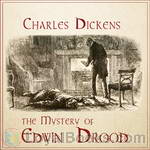 The Mystery of Edwin Drood
The Mystery of Edwin Drood
The Mystery of Edwin Drood is the final novel by Charles Dickens. It is a mystery indeed; the serial novel was just half completed at the time of Dickens’ death – leading to much speculation how it might have ended.The novel is named after Edwin Drood, one of the characters, but it mostly tells the story of his uncle, a choirmaster named John Jasper, who is in love with his pupil, Rosa Bud. Miss Bud is Drood’s fiancée, and has also caught the eye of the high-spirited and hot-tempered Neville Landless! Landless comes from Ceylon with his twin sister, Helena... | |
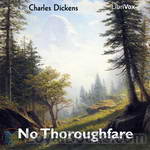 No Thoroughfare
No Thoroughfare
Two boys from the Foundling Hospital are given the same name, with disastrous consequences in adulthood. Two associates, wishing to right the wrong, are commissioned to find a missing heir. Their quest takes them from fungous wine cellars in the City of London to the sunshine of the Mediterranean — across the Alps in winter. Danger and treachery would prevail were it not for the courage of the heroine and the faithful company servant. The story contains crafted descriptions, well-drawn and diverse... | |
 A House to Let
A House to Let
A House to Let is a novella originally published in 1858 in the Christmas edition of Dickens’ Household Words magazine. Each of the contributors wrote a chapter (stories within a story, and in the case of Adelaide Anne Procter, as a story in verse) and the whole was edited by Dickens. The plot concerns an elderly woman, Sophonisba, who notices signs of life in a supposedly empty dilapidated house (the eponymous “House to Let”) opposite her own, and employs the efforts of an elderly admirer, Jabez Jarber, and her servant, Trottle, to discover what is happening within. | |
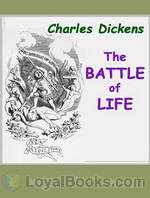 The Battle of Life
The Battle of Life
While "The Battle of Life" is one of Charles Dickens' Christmas Books - his annual release of a story just before Christmas - this one breaks the tradition by not being concerned with Christmas. Rather, its subtitle, "A Love Story", reveals more of the plot. The major events of this book take place on land that once was a battleground. That is just a backdrop for Dickens' idea of the real battle of life - finding and winning the right partner, so that life will go on to the next generation. The family that lives there is rather confused in its affections and intentions regarding who should end up with whom... | |
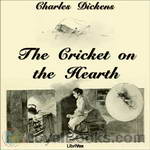 The Cricket on the Hearth
The Cricket on the Hearth
The tale of John Peerybingle, the good-hearted carrier, and his young wife Mary ('Dot'), interwoven with the story of poor toymaker Caleb Plummer, his beloved blind daughter Bertha, and the harsh old toy merchant Tackleton, who is due to marry May Fielding, a childhood friend of Dot. Comic relief is provided by Tilly Slowboy, the disaster-prone nursemaid of John and Dot's baby, and Boxer, the family dog.The cricket who chirps on the family hearth assumes fairy form to save the day when disaster looms in the form of a mysterious stranger... | |
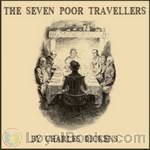 The Seven Poor Travellers
The Seven Poor Travellers
One of Dickens’ Christmas stories, this was first published as part of the Christmas number of Household Words for 1854. The first chapter relates Dickens’ visit to the ancient Richard Watts’s Charity at Rochester. The second chapter is the touching story of “Richard Doubledick”, which Dickens supposedly told the travellers, and Dickens’ journey home on Christmas morning provides the short concluding chapter. | |
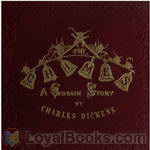 The Chimes
The Chimes
The Chimes: A Goblin Story of Some Bells that Rang an Old Year Out and a New Year In is the second of Charles Dickens' Christmas books, published in 1844. Its contemporary setting is the "Hungry Forties", a time of social and political unrest, and the book has a strong moral message. It remained popular for many years, although its fame has since been eclipsed by that of A Christmas Carol, the first of the series. Our hero Toby ("Trotty") Veck is a poor but hard-working man, whose beloved daughter Meg is due to marry on New Year's Day... | |
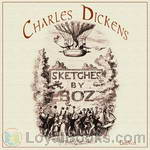 Sketches by Boz: Illustrative of Every-Day Life and Every-Day People
Sketches by Boz: Illustrative of Every-Day Life and Every-Day People
"Sketches by "Boz," Illustrative of Every-day Life and Every-day People (commonly known as Sketches by Boz) is a collection of short pieces published by Charles Dickens in 1836 accompanied by illustrations by George Cruikshank. The 56 sketches concern London scenes and people and are divided into four sections: "Our Parish", "Scenes", "Characters", and "Tales". The material in the first three of these sections is non-fiction. The last section comprises fictional stories. Originally, the sketches were published in various newspapers and periodicals from 1833-1836." | |
 Charles Dickens 200th Anniversary Collection Vol. 1
Charles Dickens 200th Anniversary Collection Vol. 1
The Charles Dickens 200th Anniversary Collection comprises short works - fiction, essays, poetry, letters, magazine articles and speeches - and each volume will be a pot pourri of all genres and periods of his writing. This first volume is released on Dickens' 200th birthday, February 7th 2012. Further volumes will follow during the anniversary year.Volume 1 includes short stories including, amongst others, The Holly Tree, the first part of Holiday Romance and three pieces from Mugby Junction.Some... | |
 The Haunted Man and the Ghost's Bargain
The Haunted Man and the Ghost's Bargain
The Haunted Man and the Ghost’s Bargain, A Fancy for Christmas-Time, (better known as The Haunted Man and the Ghost’s Bargain) is a novella by Charles Dickens first published in 1848. It is the fifth and last of Dickens' Christmas novellas. The story is more about the spirit of the holidays than about the holidays themselves, harking back to the first of the series, A Christmas Carol. The tale centers around a Professor Redlaw and those close to him. | |
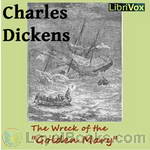 The Wreck of the Golden Mary
The Wreck of the Golden Mary
A short story of a ship wreck in 1851 trying to round Cape Horn on its way to the California gold fields. Poignant and well written. ( | |
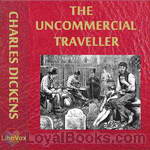 The Uncommercial Traveller
The Uncommercial Traveller
The Uncommercial Traveller is a collection of literary sketches and reminiscences written by Charles Dickens. In 1859 Dickens founded a new journal called All the Year Round and the Uncommercial Traveller articles would be among his main contributions. He seems to have chosen the title and persona of the Uncommercial Traveller as a result of a speech he gave on the 22 December 1859 to the Commercial Travellers' School London in his role as honorary chairman and treasurer. The persona sits well with a writer who liked to travel, not only as a tourist, but also to research and report what he found; visiting Europe, America and giving book readings throughout Britain... | |
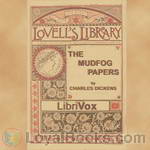 Mudfog and Other Sketches
Mudfog and Other Sketches
The Mudfog Papers was written by Victorian era novelist Charles Dickens and published from 1837–38 in the monthly literary serial Bentley's Miscellany, which he then edited. They were first published as a book as 'The Mudfog Papers and Other Sketches. The Mudfog Papers relates the proceedings of the fictional 'The Mudfog Society for the Advancement of Everything', a Pickwickian parody of the British Association for the Advancement of Science founded in York in 1831, one of the numerous Victorian learned societies dedicated to the advancement of Science... | |
 The Magic Fishbone A Holiday Romance
The Magic Fishbone A Holiday Romance
| |
 A Message from the Sea
A Message from the Sea
| |
 Captain Boldheart & the Latin-Grammar Master
Captain Boldheart & the Latin-Grammar Master
| |
 Lazy Tour of Two Idle Apprentices
Lazy Tour of Two Idle Apprentices
| |
 Mugby Junction
Mugby Junction
| |
 The Trial of William Tinkling
The Trial of William Tinkling
| |
 To Be Read at Dusk
To Be Read at Dusk
| |
 The Holly-Tree
The Holly-Tree
| |
 Doctor Marigold
Doctor Marigold
| |
 The Lamplighter; a farce in one act
The Lamplighter; a farce in one act
| |
 Somebody's Luggage
Somebody's Luggage
| |
 Tom Tiddler's Ground
Tom Tiddler's Ground
| |
 Reprinted Pieces
Reprinted Pieces
| |
 Perils of Certain English Prisoners
Perils of Certain English Prisoners
| |
 Mrs. Lirriper's Legacy
Mrs. Lirriper's Legacy
| |
 Going into Society
Going into Society
| |
 Mrs. Lirriper's Lodgings
Mrs. Lirriper's Lodgings
| |
 George Silverman's Explanation
George Silverman's Explanation
| |
 Mugby Junction
Mugby Junction
| |
 Haunted Man and the Ghost's Bargain (version 2)
Haunted Man and the Ghost's Bargain (version 2)
The last of Dickens' Christmas novellas (1848), The Haunted Man and the Ghost's Bargain centres around Professor Redlaw, a teacher of chemistry, whose personal life has been marred by sorrow and, he feels, by wrongs done to him in his past. He is haunted by his ghostly twin, who offers him the opportunity to forget completely all 'sorrow, wrong and trouble', claiming that this will make him happier. Redlaw wavers, but finally accepts this offer, discovering too late that there are conditions attached to it which cause him to infect with this unwanted 'gift' nearly everyone with whom he comes in contact... | |
 Life and Adventures of Nicholas Nickleby (Version 3)
Life and Adventures of Nicholas Nickleby (Version 3)
Nicholas Nickleby was Dickens's third novel following on from Pickwick Papers and Oliver twist. It has a cast of wonderful characters that include Wackford Squeers, the reprehensible and villainous headmaster whose reign of terror at his school in Yorkshire resulted in the abuse and deaths of many of his unwanted and orphaned children, Mr Vincent Crummles and his hilariously inept touring company, the munificent Cheeryble brothers, Ralph Nickleby, Nicholas's uncle, a mean spirited man who is driven... | |
 Christmas Carol - Condensed by the Author for his Dramatic Readings
Christmas Carol - Condensed by the Author for his Dramatic Readings
This very special abridged version was written and performed by Dickens himself during his American Tour of 1862. Without the more terrifying and dark elements of the full length novel, its hour and a half length, and its lighter, comedic style makes this a family listening experience suited for all ages. ( Michael Armenta) | |
 David Copperfield - Condensed by the Author for his Dramatic Readings in America
David Copperfield - Condensed by the Author for his Dramatic Readings in America
"This short collection of 6 selected scenes from "David Copperfield" were abridged and performed by Dickens himself during his American Tour of 1867 and 1868." | |
 Christmas Stories From 'Household Words' And 'All The Year Round'
Christmas Stories From 'Household Words' And 'All The Year Round'
Twenty stories originally published in the Christmas editions of the magazines “Household Words” and “All The Year Round”. Some of the stories have little holiday sentiment and exhibit much of the indignation Dickens felt at the social and economic injustices of his day. Some of the stories were written in collaboration with other authors. The editor of this volume chose to omit those other chapters and include only Dickens' work. The result is that some of the stories are a bit choppy, not to say confusing. | |
 Christmas Books
Christmas Books
From 1843 to 1848, Charles Dickens wrote a series of five novellas to be published at Christmas. Most people are familiar with the first, "A Christmas Carol." The others are "The Chimes," "The Cricket on the Hearth," "The Battle of Life," and "The Haunted Man and the Ghost's Bargain." | |
By: Charles Dudley Warner (1829-1900) | |
|---|---|
 That Fortune
That Fortune
| |
 Little Journey in the World
Little Journey in the World
| |
 The Golden House
The Golden House
| |
By: Charles E. (Charles Emmett) Van Loan (1876-1919) | |
|---|---|
 Old Man Curry Race Track Stories
Old Man Curry Race Track Stories
| |
By: Charles E. Carryl (1841-1920) | |
|---|---|
 Davy and the Goblin
Davy and the Goblin
Eight-year-old Davy reads Lewis Carroll's novel Alice's Adventures in Wonderland and begins to get very sleepy. Suddenly a goblin appears in the fire and takes Davy on a "believing voyage" much like Alice's own adventures in Wonderland, where he meets many characters from fantasy and literature. | |
 The Admiral's Caravan
The Admiral's Caravan
| |
By: Charles Edward Pearce (-1924) | |
|---|---|
 Madame Flirt A Romance of 'The Beggar's Opera'
Madame Flirt A Romance of 'The Beggar's Opera'
| |
By: Charles Edward Rich | |
|---|---|
 A Voyage with Captain Dynamite
A Voyage with Captain Dynamite
| |
By: Charles Felton Pidgin (1844-1923) | |
|---|---|
 Quincy Adams Sawyer and Mason's Corner Folks A Picture of New England Home Life
Quincy Adams Sawyer and Mason's Corner Folks A Picture of New England Home Life
| |
 Further Adventures of Quincy Adams Sawyer and Mason Corner Folks
Further Adventures of Quincy Adams Sawyer and Mason Corner Folks
| |
By: Charles Franklin Carter | |
|---|---|
 Old Mission Stories of California
Old Mission Stories of California
| |
By: Charles G. D. Roberts (1860-1943) | |
|---|---|
 Hoof and Claw
Hoof and Claw
These 14 short stories about animals are superb examples of Roberts smooth storytelling style. Knows as the Father of Canadian Poetry, he loved to also write in prose about the wilderness and the personalities of the animals to be found there as well as the exciting things they are capable of. Bears, White Wolves, Lynxs, hawks and yes, cattle are just a few of the animals written about. | |
By: Charles Garvice (-1920) | |
|---|---|
 The Woman's Way
The Woman's Way
| |
 Adrien Leroy
Adrien Leroy
| |
 Nell, of Shorne Mills or, One Heart's Burden
Nell, of Shorne Mills or, One Heart's Burden
| |
By: Charles George Douglas Roberts (1860-1943) | |
|---|---|
 Children of the Wild
Children of the Wild
| |
By: Charles Goddard (1879-1951) | |
|---|---|
 The Perils of Pauline
The Perils of Pauline
The Perils of Pauline is one of the first damsel in distress serials. The story is complete with undaunted hero, courageous damsel, unscrupulous villains galore, and other worldly interest. Before getting married, Pauline wants to experience the world and have adventures. When her guardian dies and leaves her an estate in trust of his secretary, adventures suddenly become more hazardous. Pauline charters aeroplanes, meets untrustworthy pirates, braves dangerous China Town, flies in a hot air balloon, adventures in the Wild West, encounters international spies, and escapes many other perils with the aid of her would-be fiancé, Harry, and an Egyptian mummy. | |
By: Charles Goddard and Paul Dicky | |
|---|---|
 The Ghost Breaker
The Ghost Breaker
The Ghost Breaker is a drama and haunted house horror complete with heroes, villains, and a Princess. The Ghost Breaker was originally a screenplay and would later be made a drama film directed by Cecil B. DeMille. | |
By: Charles Godfrey Leland (1824-1903) | |
|---|---|
 Algonquin Legends of New England or Myths and Folk Lore of the Micmac, Passamaquoddy, and Penobscot Tribes
Algonquin Legends of New England or Myths and Folk Lore of the Micmac, Passamaquoddy, and Penobscot Tribes
This work, then, contains a collection of the myths, legends, and folk-lore of the principal Wabanaki, or Northeastern Algonquin, Indians; that is to say, of the Passamaquoddies and Penobscots of Maine, and of the Micmacs of New Brunswick. All of this material was gathered directly from Indian narrators, the greater part by myself, the rest by a few friends; in fact, I can give the name of the aboriginal authority for every tale except one. | |
By: Charles Goff Thomson | |
|---|---|
 Terry A Tale of the Hill People
Terry A Tale of the Hill People
| |
By: Charles H. Bennett (1829-1867) | |
|---|---|
 The Faithless Parrot
The Faithless Parrot
| |
 The Frog Who Would A Wooing Go
The Frog Who Would A Wooing Go
| |